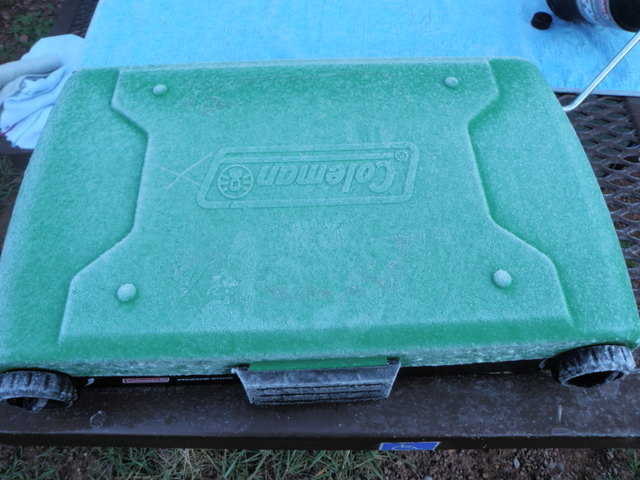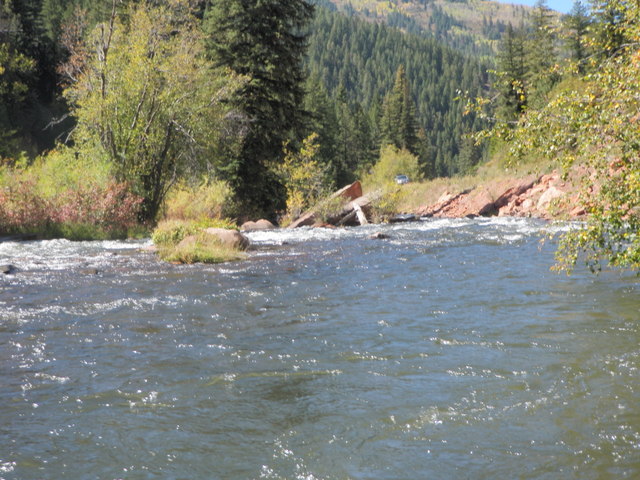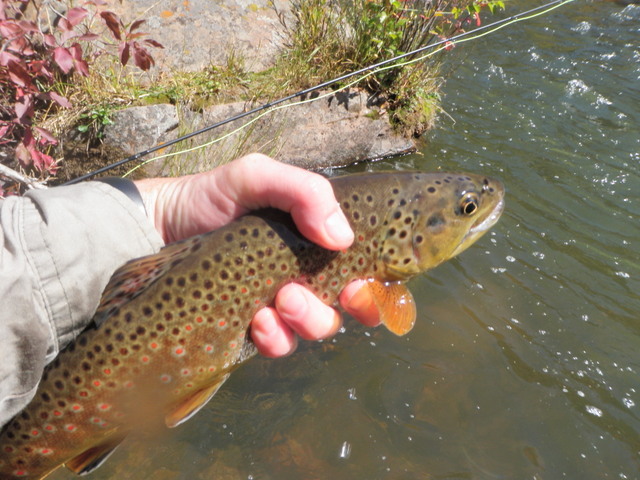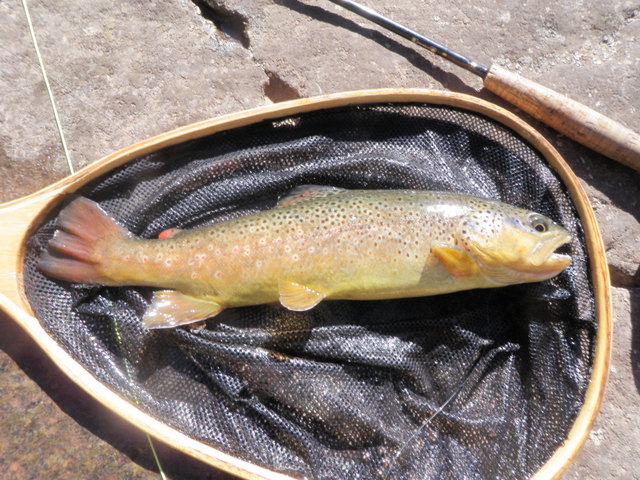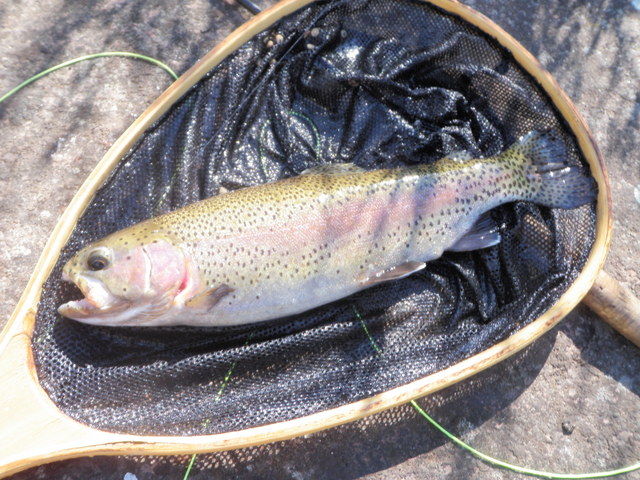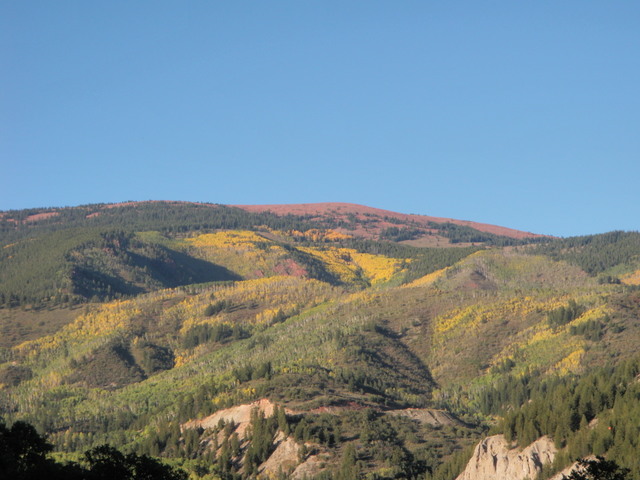Time: 10:30AM – 5:30PM
Location: Downstream from spring; within one mile of dam; across from the spring.
Fish Landed: 23
Frying Pan River 09/14/2012 Photo Album
Friday brought frustrations other than the picky fish that I experienced on Thursday between 1 and 3, but I’m getting ahead of myself.
I woke up Friday morning to a fresh coat of frost on the tablecloth, stove and windshield. It was quite cold, but as soon as the sun rose over the eastern ridge at 8AM, things warmed up quickly. After a quick breakfast I retrieved all my various fly boxes from my fishing bag and spread them out on the picnic table at the campsite (after wiping off the water from thawed frost). I selected all the imitations of green drakes that were dispersed among three or four boxes and then grouped them into a large size 12 pile and a smaller size 14 pile. I put four size 14 comparaduns in my front pack patch, a couple size12’s, and three Wellerfish paradrakes. I was now prepared for whatever green drakes the Frying Pan River could throw at me.
I decided to drive down to the spring area to begin my fishing in the morning as there was a lot of pocket water that was ideal for the hopper/dropper technique and that area was further away from the ridge and therefore would warm in the sun more quickly. Once again I began with a Chernobyl ant and beadhead hares ear combination and once again this yielded only refusals and no fish. I exchanged the Chernobyl for a parachute hopper and this yielded one small brown on the BHHE. As I was working up along the bank next to the road I began to observe quite a few midges zooming up from the surface of the water so I added a zebra midge beneath the beadhead hares ear and fished three flies.
I was optimistic that the midge would yield some action, but in a short amount of time I snagged a stick and in the process of trying to free the flies, I broke off both the hares ear and zebra midge, probably as a result of an aging knot. This forced me to replace the hares ear with a new model, and as I looked at the midge section of my fly patch I decided to try an olive colored beadhead midge larva. This combination brought me some decent action between 11 and 12 as I built my count to six with three hitting the beadhead hares ear and two hooked on the midge. I also had perhaps five or six hooked but unable to land presumably on the tiny size 22 midge hook.
At the top of a tiny island I momentarily hooked a rainbow that appeared to be in excess of fifteen inches, but it made a quick turn of its head to the left and the fly popped free. To say the least I was quite disappointed by this turn of events. During this time I discovered that I generated more action by casting directly across from my position and allowing the flies to drift downstream and then swing. As the fly was drifting downstream I made quick jerky mends that gave the trailing flies action, and quite a few of the fish hit the nymphs on the lift or swing.
At noon I broke for lunch and drove back up the road to a favorite spot close to the dam. The river angles toward the bank and creates several nice runs of moderate depth. After lunch I positioned myself at the base of one of the angled runs and began to fish with the three fly combination still in place from the spring. Not much was happening however until 1:30 when I noticed the fisherman across and down from me landing several fish. I stepped back toward the bank a bit to gain a higher vantage point and noticed he was nymphing, so I invested time in going to a strike indicator, split shot, beadhead hares ear and beadhead pheasant tail in hopes that the fish would be tuned into PMD nymphs prior to a hatch. It was a great thought process, but it didn’t yield any fish.
Shortly after going to the trouble of converting to deep nymphing I began to see light yellow colored mayflies and sporadic rises. I was in a precarious position sitting on a raised boulder with my legs on each side similar to riding a horse with a deep chasm between me and another large boulder anchored to the bank. While balanced in this position I clipped off the nymph paraphernalia and tied on the sulfur comparadun. Using this fly I landed a small brown from the small run and riffle above me, but then I noticed a single rise twenty feet below me beneath an overhanging branch that came within 18 inches of the surface of the river. I began making downstream drifts by simply feeding out line and letting the fly drift down along the current seam. On the fifth or sixth downstream drift a fifteen inch brown smashed the sulfur from beneath the branch. What a thrill!
I spun around on my rock and focused my attention on the small triangular pool sandwiched between the surrounding runs above me. Two or three nice fish were visible and had now begun feeding actively, but they were ignoring my yellow comparadun. They showed slight interest as evidenced by a slight move up toward the fly or a tail wag, but that was the most energy they would expend on my frauds. I decided to halt my frantic casting for a bit and watch the water and much to my surprise I noticed a dense hatch of small BWO’s on the water! I quickly switched to my CDC BWO and on the first cast landed a nice 14 inch brown from the triangular pool area.
It was around this time that I was distracted by a man and woman who arrived and waded into positions no more than 10 yards above me. I immediately yelled, “Hey! Hey!”, but the man either didn’t hear me or chose to ignore me. I later discovered that the woman was likely the man’s teenage daughter. I was pretty irate about this turn of events as I was now hemmed in to a small area after arriving two hours earlier and staking my claim to the space. There wasn’t much I could do at this point short of confronting the man, so I refocused on the fish in front of me. Another fish continued to feed at the very tail or point of the triangle just above where currents merged, and I needed to run quite a few casts over him, but eventually I convinced a 13″ brown to chomp on the CDC BWO.
Meanwhile I continued to see a sparse hatch of PMD’s, and I thought perhaps the fish would switch to these larger morsels, but I stuck with the tiny BWO imitation. I had now taken two nice fish from the triangle area and disturbed the water a couple times and wasn’t seeing any more feeding activity. Just above me was another small riffle where a side current ran almost perpendicular to the main river and deflected off the bank and then continued along the bank to the rock I was sitting on. Unfortunately between me and the run was a large branch that extended over the water by five feet or so. I began to hook casts to the run above the branch, and as I did this I spotted a barely visible sip in front of the branch. Because this water was very riffled, I was having great difficulty seeing the tiny gray tuft of a fly, but I began dropping casts further to the left and closer to the rise. On perhaps the third such cast the rainbow moved for my fly and smashed it and shortly thereafter he was in my net.
I was pretty much hemmed in now with nowhere to go but up the bank, so that’s what I did, and then I had the evil idea to return the favor. I found an opening in the dense vegetation between the road and the river and decided to explore as I couldn’t really see how much above the intrusive pair it would take me. Unfortunately I appeared only five yards or so above the girl. I was on a long fairly flat rock that protruded out in the river, and this created a nice little pocket where the river curved from the bank and rushed around the rock. I began dropping extremely short casts into the tiny pocket, but I wasn’t very confident this held a fish. Amazingly on the fifth or sixth cast a chunky 13″ brown emerged from the current seam and sipped in my CDC BWO. I took the time to be obvious about my nice fish and placed it on my net on the large rock to photograph. I still couldn’t coax a look or remark from the father who stoically fished and faced the main river.
Now I was truly out of decent water so I retreated to the Santa Fe and decided to drive downstream and check out the area that I fished on Thursday. What a shock I was in for. On this pleasant Friday in September apparently a lot of fishermen decided to take a long weekend to fish. All the pullouts were full and there were guides with multiple anglers near bush rock riffle and in fallen tree pool. There was a fisherman positioned in the pool below large rectangular rock. Before I knew it I was out of the public water and driving along the private water and beyond mile marker 11. Fortunately there was no one at the spring area so I pulled into the pullout there and geared up to fish.
I was really fuming at this point as I’d been forced out of my prime spot just as I solved the hatch riddle. I’d landed six very nice fish in a very confined space, and the last four sipped in my CDC BWO with confidence. It was tough to accept the fact that I relinquished this favorable situation.
I began wading across the river to reach the opposite bank as I planned to fish up through the series of runs and pools that had produced for me in late August. The crossing was quite challenging as the flows were roughly 50 cfs higher than August. Since I still had the CDC BWO on my line, I gave that a try initially and landed a small brown, but I wasn’t seeing many rises and the tiny BWO was very difficult to follow in this faster more turbulent pocket water.
I switched to the money fly and landed another medium sized brown, but the quality of this fishing experience really suffered compared to the enjoyment I had just experienced closer to the dam. I was consoling myself that at least I’d now landed 14 fish on the Frying Pan, and even if I quit now, it was a decent day. Just as this thought ran through my brain at around 3PM, all hell broke loose. I saw BWO’s and PMD’s (some yellow and some gray) and green drakes simultaneously popping off the water. When I noticed quite a few green drakes tumbling in the surface film and trying to lift off, I decided to take advantage of my earlier fly sorting and tied on one of the size 14 comparaduns. My fly search paid huge dividends as I landed another nine fish over the remainder of the afternoon on the smaller green drakes. Three or four of the fish in this mix were strong 14 – 15 inch fish including a hard fighting rainbow that demanded quite a few casts but eventually succumbed to the allure of my green drake.
During this entire period a heavy PMD hatch was taking place, and I considered switching but stuck with the green drake, and didn’t regret this decision. By 4:30 the green drake hatch had largely fizzled out, but I observed a continued fairly strong PMD hatch so I tied on the money fly and prospected some attractive spots. I wasn’t able to entice any fish during this last half hour and saw minimal rises in spite of the fairly decent ongoing hatch. I can only conclude that the fish had full bellies by this time late in the afternoon.
As I carefully waded back to my car by the spring I could only thank the father and daughter team and all the other fishermen and guides for forcing me downstream to the spring area where I had the entire stretch of river to myself while PMD’s, BWO’s and green drakes hatched in dense numbers simultaneously. For some reason I get all the tough breaks.

